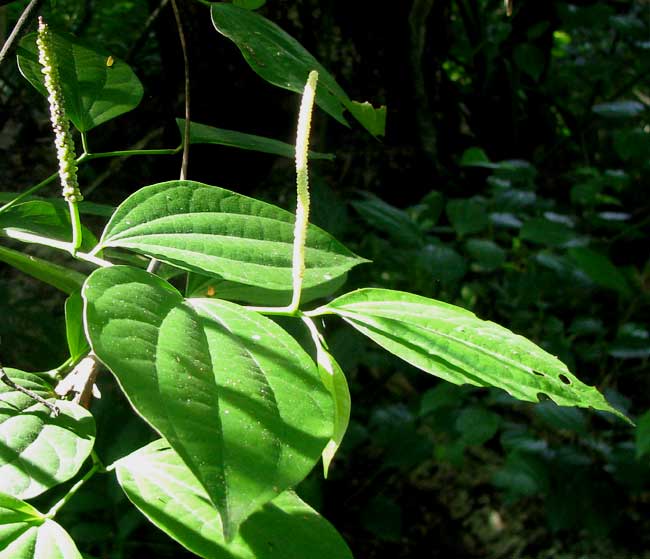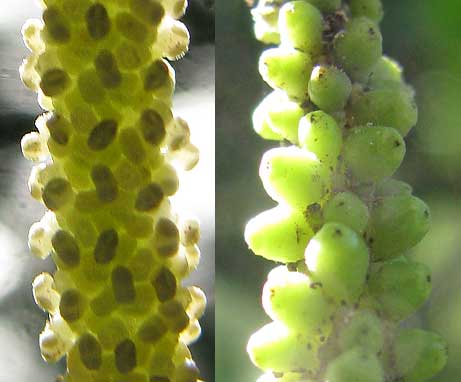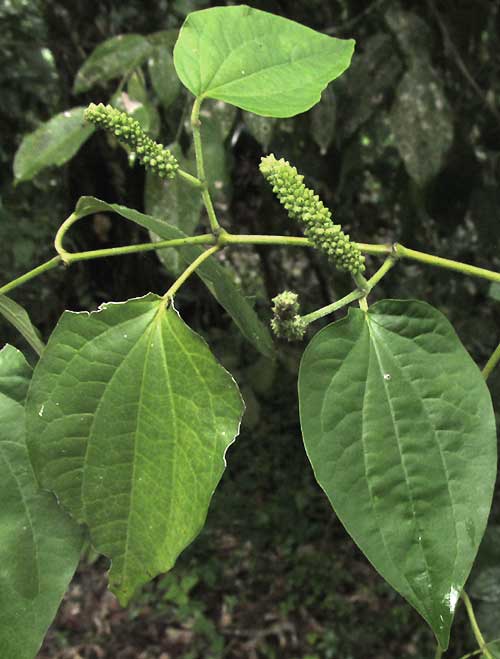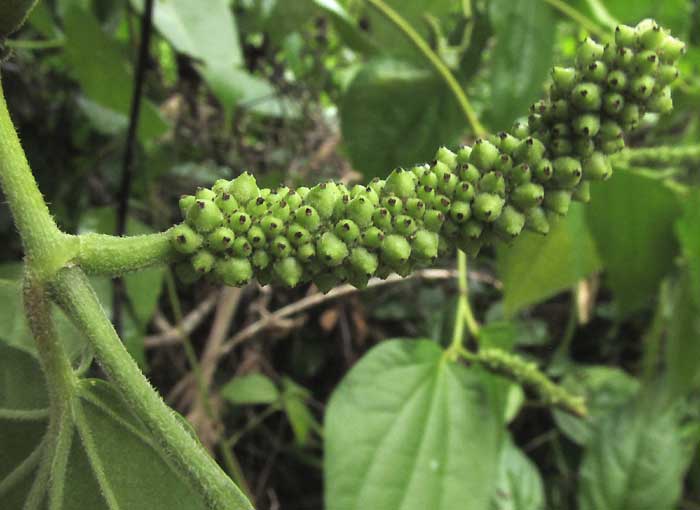Excerpts from Jim Conrad's
Naturalist Newsletter

from the November 29, 2009 Newsletter issued from Hacienda Chichen Resort beside Chichén Itzá Ruins, central Yucatán, MÉXICO; limestone bedrock, elevation ~39m (~128ft), ~N18.52°, ~W95.15°
ROUGH-LEAVED PEPPER
Above you see another shrub, usually about eight feet tall, flowering now because it flowers throughout the year. It's one of many species of the tropical Black Pepper Family, the Piperaceae, in which also belong the Peperomias often grown indoors in pots up North. In English-speaking Jamaica they call the pictured species Rough-leaved Pepper. It's PIPER AMALAGO. In Spanish, members of the genus Piper are usually referred to collectively as Cordoncillos, which means "little strings."
The slender, erect items arising vertically from the stems, the "little strings," are spikes covered by hundreds of individual, very tiny, simple flowers. You can see the spikes in two stages of development below:

In that picture the spike at the left is covered with splitting-open, baglike male anthers releasing pollen, while the spike at the right is covered with immature fruits, each fruit developing from a different flower.
Mature fruits only grow to the size of mustard seeds, but when dried and ground they taste just like black pepper. Black pepper is made from peppercorns from the topical Asian Piper species, Piper nigrum, so our Piper amalago has every right to taste like black pepper. In Jamaica sometimes our species still is used as a condiment, the fruits being picked when full grown but not completely mature, for if they mature on the plant they lose their pungency and get soft. Immature fruits, often harvested still attached to their stalks, are dried in the sun and then ground in mills.
Infusions of the leaves are said to alleviate colic and intestinal gas. The roots are used as a diuretic and to treat water retention.
from the March 1, 2019 Newsletter with notes from Chiapas, the southernmost state of MÉXICO
ROUGH-LEAFED PEPPER'S IMMATURE PEPPERCORNS
Last October 4th, 2018, when I was camping in Palenque National Park in Mexico's southernmost state of Chiapas, at a forest edge I came upon a Rough-leafed Pepper bearing fruiting heads loaded with future peppercorns, as can be seen below:

A close-up of the immature fruits/future peppercorns is seen below:

In that picture, each tiny, green, egg-shaped item topped with a little black tuft is a maturing ovary, a future peppercorn. The black items are the shriveled-up remains of the ovary's stigma, that part on which pollen grains land, bearing male sex germs.
These maturing ovaries are too young to dry and grind for use as fresh black pepper, but later they will be, and the pungent pepper produced is just about as good as that provided by the closely related Asian Piper nigrum. For use as pepper condiment, the fruits should be collected a little before reaching complete maturity, because at that point they soften and lose their pungency.
Several traditional medicinal uses are listed for the species. In 2016 M. Mullally and others published a paper in the Journal of Ethnopharmacology (Jun 5, 185:147-54) inspired by reports of Piper amalago being used by Maya Q'eqchi' healers for the treatment of susto. The Spanish word susto translates to "fear," but the condition is more complex than that, and is believed in by many of the Yucatan's Maya, including some of my friends. The researchers referred to susto as "a culture-bound syndrome" that may be a manifestation of anxiety. Therefore, they wanted to know if doses of Piper amalago might reduce anxiety levels.
Rats were fed low doses of ethanolic extracts from Piper amalago leaves. The researchers observed "significant anxiolytic activity in all behavioral tests" (they became less anxious), and even identified a kind of molecule in the extract that was structurally similar to a molecule known to affect anxiety levels.
They concluded that Maya Q'eqchi' healers may be right to treat their susto patients with Piper amalago.